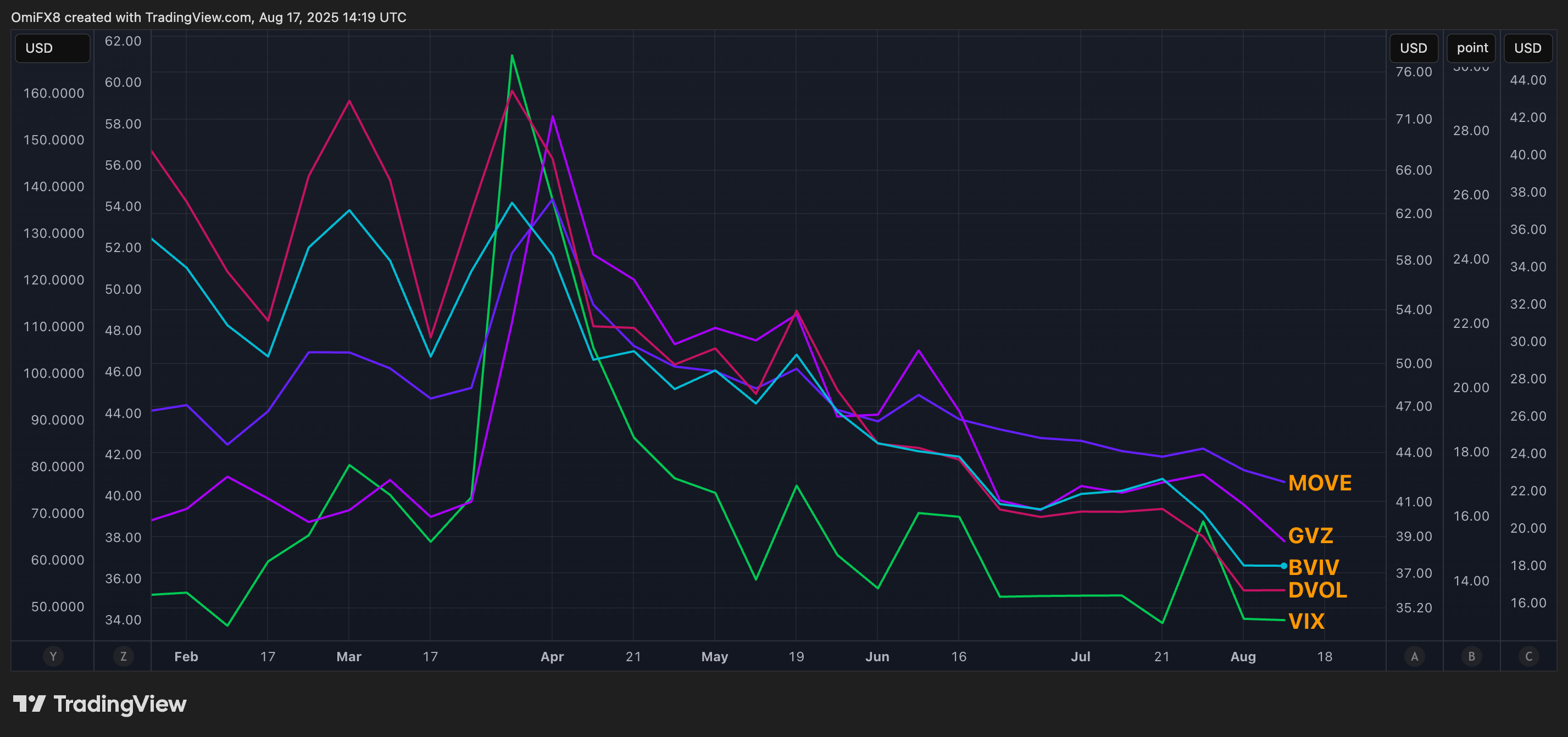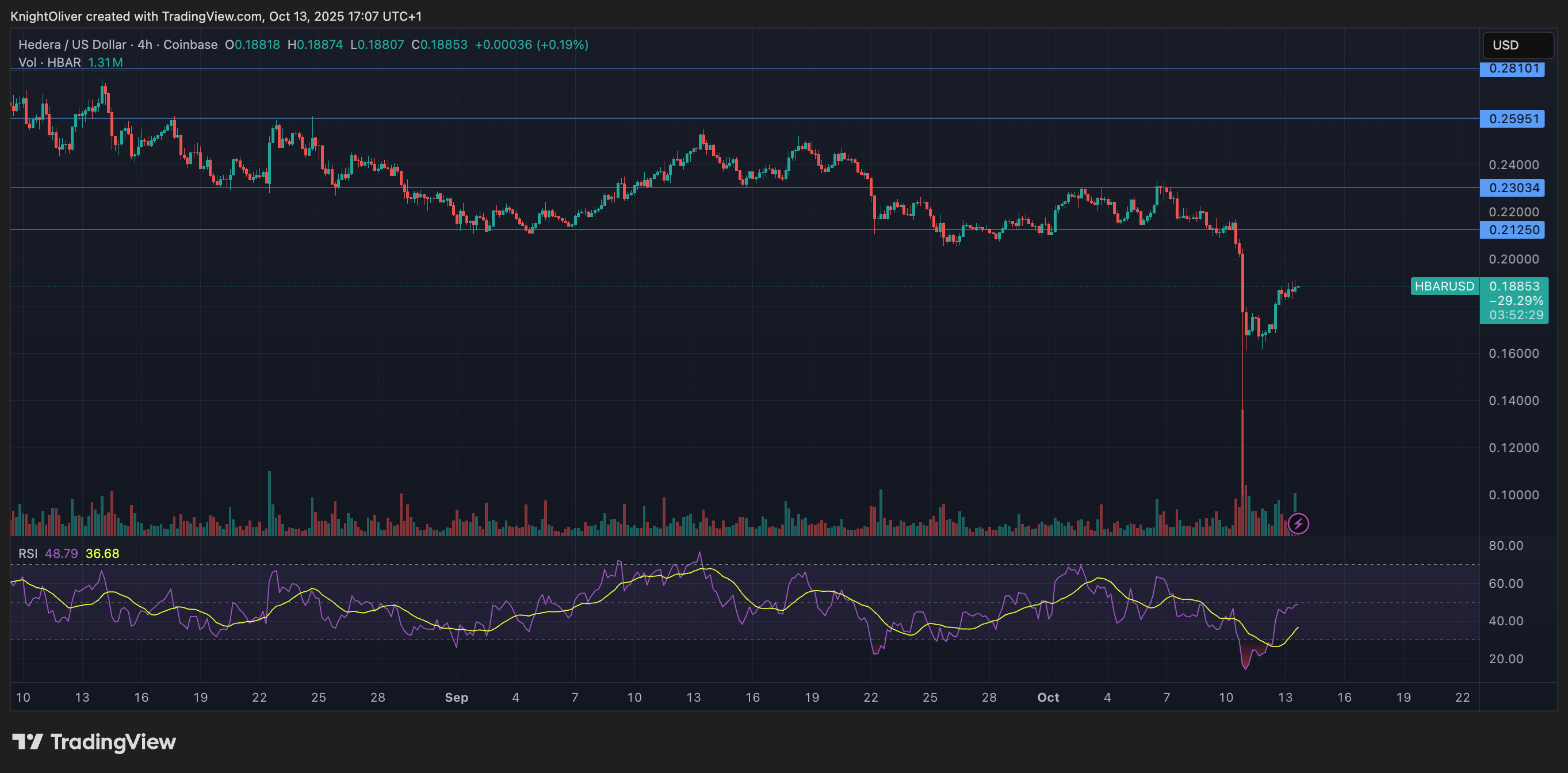Uncategorized
Volatility Vanishes Across Markets as Traders Brace for Powell’s Jackson Hole Speech

A pervasive calm has taken hold of asset classes as traders look forward to Federal Reserve (Fed) Chairman Jerome Powell’s speech at the annual Jackson Hole Symposium, scheduled for Aug. 21-23.
Bitcoin’s (BTC) 30-day implied volatility, as measured by Volmex’s BVIV and Deribit’s DVOL index, has declined sharply in recent months, hovering near two-year lows of around 36% last week, according to TradingView data.
Similarly, the CME Gold Volatility Index (GVZ), which estimates the expected 30-day volatility of returns for the SPDR Gold Shares ETF (GLD), has more than halved over the past four months, dropping to 15.22%—its lowest level since January.

The MOVE index, which tracks the 30-day implied volatility of Treasury notes, has also declined in recent months, reaching a 3.5-year low of 76%.
Meanwhile, the VIX, widely regarded as Wall Street’s «fear gauge,» fell below 14% last week, down substantially from its early April highs near 45%. A similar vol compression is seen in FX majors such as the EUR/USD.
Rates are ‘still high’
The pronounced slide in volatility across major assets comes as central banks, particularly the Fed, are expected to deliver rate cuts from restrictive territory, rather than amid a crisis.
«Most major economies are not easing from ultra-low or emergency levels like we saw after the financial crisis or during COVID. They’re cutting from restrictive territory, meaning rates are still high enough to slow growth, and in many cases, real rates, adjusted for inflation, are still positive. That’s a big shift from the last easing cycles, and it changes how the next phase plays out,» pseudonymous observer Endgame Macro noted on X, explaining the bull run in all assets, including cryptocurrencies and stock markets.
According to the CME’s FedWatch tool, the Fed is expected to cut rates by 25 basis points in September, resuming the easing cycle after an eight-month pause. Investment banking giant JPMorgan expects the benchmark borrowing cost to drop to 3.25%-3.5% by the end of the first quarter of 2026, a 100-basis-point decrease from the current 4.25%.
Per some observers, Powell could lay the groundwork for fresh easing during this Jackson Hole speech.
«The path to rate cuts may be uneven, as we have seen over the last two years, where markets have been eager for rate cuts and sometimes disappointed that the Fed has not delivered them. But we believe the direction of travel for rates is likely to remain lower,» Angelo Kourkafas, a senior global investment strategist at Edward Jones, said in a blog post on Friday.
«With inflation treading water and labour-market strains becoming more pronounced, the balance of risks may soon tip toward action. Chair Powell’s upcoming remarks at Jackson Hole could validate the now-high expectations that, after a seven-month pause, rate cuts will resume in September,» Jones added.
In other words, the decline in volatility across asset classes likely reflects expectations for easy monetary policy and economic stability.
Markets too complacent?
However, contrarians may view it as a sign that markets are too complacent, as President Donald Trump’s trade tariffs threaten to weigh on economic growth, and the latest data points to sticky inflation.
Just take a look at the price levels for most assets, including BTC and gold: They are all at record highs.
Prosper Trading Academy’s Scott Bauer argued last week during an interview with Schwab Network that volatility is too low following the recent round of economic data, with more uncertainty on the horizon.
The argument for market complacency gains credence when viewed against the backdrop of bond markets, where corporate bond spreads hit their lowest since 2007. That prompted analysts at Goldman Sachs to warn clients against complacency and take hedges.
“There are enough sources of downside risks to warrant keeping some hedges on in portfolios,” Goldman strategists led by Lotfi Karoui wrote in a note dated July 31, according to Bloomberg.
“Growth could surprise further to the downside,” dis-inflationary pressures could fade or renewed concerns over Fed independence may fuel a sharp selloff in long-dated yields.
In any case, volatility is mean-reverting, meaning periods of low volatility typically set the stage for a return to more turbulent conditions.
Business
Strategy Bought $27M in Bitcoin at $123K Before Crypto Crash

Strategy (MSTR), the world’s largest corporate owner of bitcoin (BTC), appeared to miss out on capitalizing on last week’s market rout to purchase the dip in prices.
According to Monday’s press release, the firm bought 220 BTC at an average price of $123,561. The company used the proceeds of selling its various preferred stocks (STRF, STRK, STRD), raising $27.3 million.
That purchase price was well above the prices the largest crypto changed hands in the second half of the week. Bitcoin nosedived from above $123,000 on Thursday to as low as $103,000 on late Friday during one, if not the worst crypto flash crash on record, liquidating over $19 billion in leveraged positions.
That move occurred as Trump said to impose a 100% increase in tariffs against Chinese goods as a retaliation for tightening rare earth metal exports, reigniting fears of a trade war between the two world powers.
At its lowest point on Friday, BTC traded nearly 16% lower than the average of Strategy’s recent purchase price. Even during the swift rebound over the weekend, the firm could have bought tokens between $110,000 and $115,000, at a 7%-10% discount compared to what it paid for.
With the latest purchase, the firm brought its total holdings to 640,250 BTC, at an average acquisition price of $73,000 since starting its bitcoin treasury plan in 2020.
MSTR, the firm’s common stock, was up 2.5% on Monday.
Business
HBAR Rises Past Key Resistance After Explosive Decline

HBAR (Hedera Hashgraph) experienced pronounced volatility in the final hour of trading on Oct. 13, soaring from $0.187 to a peak of $0.191—a 2.14% intraday gain—before consolidating around $0.190.
The move was driven by a dramatic surge in trading activity, with a standout 15.65 million tokens exchanged at 13:31, signaling strong institutional participation. This decisive volume breakout propelled the asset beyond its prior resistance range of $0.190–$0.191, establishing a new technical footing amid bullish momentum.
The surge capped a broader 23-hour rally from Oct. 12 to 13, during which HBAR advanced roughly 9% within a $0.17–$0.19 bandwidth. This sustained upward trajectory was characterized by consistent volume inflows and a firm recovery from earlier lows near $0.17, underscoring robust market conviction. The asset’s ability to preserve support above $0.18 throughout the period reinforced confidence among traders eyeing continued bullish action.
Strong institutional engagement was evident as consecutive high-volume intervals extended through the breakout window, suggesting renewed accumulation and positioning for potential continuation. HBAR’s price structure now shows resilient support around $0.189–$0.190, signaling the possibility of further upside if momentum persists and broader market conditions remain favorable.

Technical Indicators Highlight Bullish Sentiment
- HBAR operated within a $0.017 bandwidth (9%) spanning $0.174 and $0.191 throughout the previous 23-hour period from 12 October 15:00 to 13 October 14:00.
- Substantial volume surges reaching 179.54 million and 182.77 million during 11:00 and 13:00 sessions on 13 October validated positive market sentiment.
- Critical resistance materialized at $0.190-$0.191 thresholds where price movements encountered persistent selling activity.
- The $0.183-$0.184 territory established dependable support through volume-supported bounces.
- Extraordinary volume explosion at 13:31 registering 15.65 million units signaled decisive breakout event.
- High-volume intervals surpassing 10 million units through 13:35 substantiated significant institutional engagement.
- Asset preserved support above $0.189 despite moderate profit-taking activity.
Disclaimer: Parts of this article were generated with the assistance from AI tools and reviewed by our editorial team to ensure accuracy and adherence to our standards. For more information, see CoinDesk’s full AI Policy.
Business
Crypto Markets Today: Bitcoin and Altcoins Recover After $500B Crash

The crypto market staged a recovery on Monday following the weekend’s $500 billion bloodbath that resulted in a $10 billion drop in open interest.
Bitcoin (BTC) rose by 1.4% while ether (ETH) outperformed with a 2.5% gain. Synthetix (SNX, meanwhile, stole the show with a 120% rally as traders anticipate «perpetual wars» between the decentralized trading venue and HyperLiquid.
Plasma (XPL) and aster (ASTER) both failed to benefit from Monday’s recovery, losing 4.2% and 2.5% respectively.
Derivatives Positioning
- The BTC futures market has stabilized after a volatile period. Open interest, which had dropped from $33 billion to $23 billion over the weekend, has now settled at around $26 billion. Similarly, the 3-month annualized basis has rebounded to the 6-7% range, after dipping to 4-5% over the weekend, indicating that the bullish sentiment has largely returned. However, funding rates remain a key area of divergence; while Bybit and Hyperliquid have settled around 10%, Binance’s rate is negative.
- The BTC options market is showing a renewed bullish lean. The 24-hour Put/Call Volume has shifted to be more in favor of calls, now at over 56%. Additionally, the 1-week 25 Delta Skew has risen to 2.5% after a period of flatness.
- These metrics indicate a market with increasing demand for bullish exposure and upside protection, reflecting a shift away from the recent «cautious neutrality.»
- Coinglass data shows $620 million in 24 hour liquidations, with a 34-66 split between longs and shorts. ETH ($218 million), BTC ($124 million) and SOL ($43 million) were the leaders in terms of notional liquidations. Binance liquidation heatmap indicates $116,620 as a core liquidation level to monitor, in case of a price rise.
Token Talk
By Oliver Knight
- The crypto market kicked off Monday with a rebound in the wake of a sharp weekend leverage flush. According to data from CoinMarketCap, the total crypto market cap climbed roughly 5.7% in the past 24 hours, with volume jumping about 26.8%, suggesting those liquidated at the weekend are repurchasing their positions.
- A total of $19 billion worth of derivatives positions were wiped out over the weekend with the vast majority being attributed to those holding long positions, in the past 24 hours, however, $626 billion was liquidated with $420 billion of that being on the short side, demonstrating a reversal in sentiment, according to CoinGlass.
- The recovery has been tentative so far; the dominance of Bitcoin remains elevated at about 58.45%, down modestly from recent highs, which implies altcoins may still lag as capital piles back into safer large-cap names.
- The big winner of Monday’s recovery was synthetix (SNX), which rose by more than 120% ahead of a crypto trading competition that will see it potentially start up «perpetual wars» with HyperLiquid.
-

 Business12 месяцев ago
Business12 месяцев ago3 Ways to make your business presentation more relatable
-

 Fashion12 месяцев ago
Fashion12 месяцев agoAccording to Dior Couture, this taboo fashion accessory is back
-

 Entertainment12 месяцев ago
Entertainment12 месяцев ago10 Artists who retired from music and made a comeback
-

 Entertainment12 месяцев ago
Entertainment12 месяцев ago\’Better Call Saul\’ has been renewed for a fourth season
-

 Entertainment12 месяцев ago
Entertainment12 месяцев agoNew Season 8 Walking Dead trailer flashes forward in time
-

 Uncategorized4 месяца ago
Uncategorized4 месяца agoRobinhood Launches Micro Bitcoin, Solana and XRP Futures Contracts
-

 Business12 месяцев ago
Business12 месяцев ago15 Habits that could be hurting your business relationships
-

 Entertainment12 месяцев ago
Entertainment12 месяцев agoMeet Superman\’s grandfather in new trailer for Krypton





